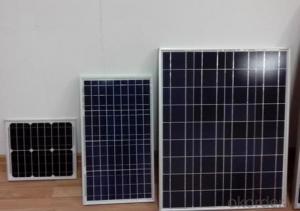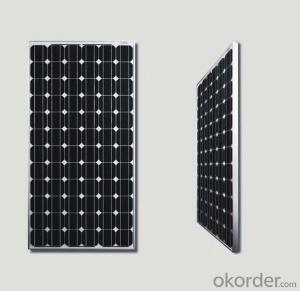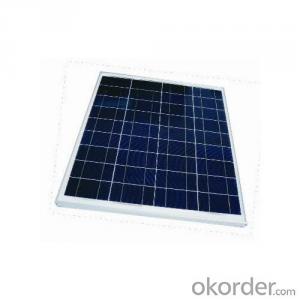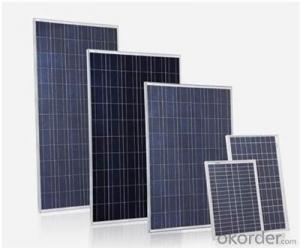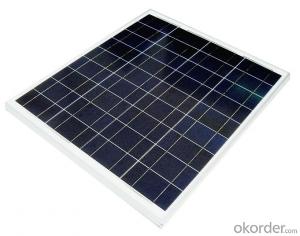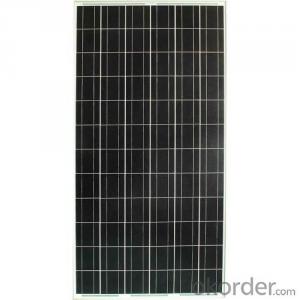Solar Polycrystalline 156mm Series (40W-----50W)
- Loading Port:
- Shanghai
- Payment Terms:
- TT OR LC
- Min Order Qty:
- 1000 watt
- Supply Capability:
- 20000000 watt/month
OKorder Service Pledge
OKorder Financial Service
You Might Also Like
Item specifice
1.Structure of Solar Module Description
Solar Polycrystalline 156mm Series (40W-----50W)
2.Characteristics of the Solar Module
| Max Power Voltage Vmp (V) | 17.8 | 17.6 | 17.4 |
| Max Power Current Imp (A) | 2.25 | 2.56 | 2.87 |
| Open Circuit Voltage Voc (V) | 22.4 | 22.2 | 22.0 |
| Short Circuit Current Isc (A) | 2.41 | 2.74 | 3.07 |
| Max Power Pm(W) | 40 | 45 | 50 |
3.Limits of the Solar Module
Operating Temperature ﹣40℃to+85℃
Storage Temperature ﹣40℃to+85℃
Max System Voltage 700V
4.Specifications of the Solar Module
| Power | 40W | 45W | 50W |
| Dimension | 470x670x30mm | 530x670x30mm | 630x670x30mm |
| Weight | 4.3kg | 4.6kg | 5.4kg |
| Tolerance | ±3% | ±3% | ±3% |
The dimension of the modules can be changed according to the demand of clients
5.Guarantee of the Solar Module
| Products Guarantee | 2 yrs free from defects in materials and
workmanship |
| Performance Guarantee | No less than 90% within 10yrs and no less than 80% within 20yrs |
| Certificates | IEC,ISO,TUV,CE |
6.Applications of the Solar Module
1.Electricity
2.Heat energy
7.IMages of the Solar Module
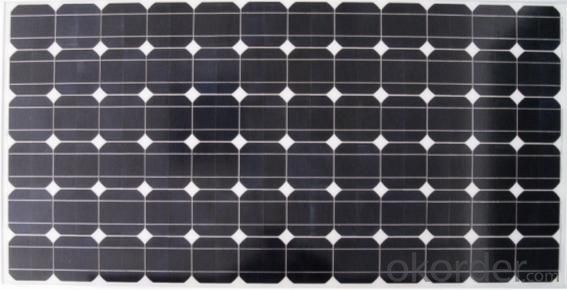
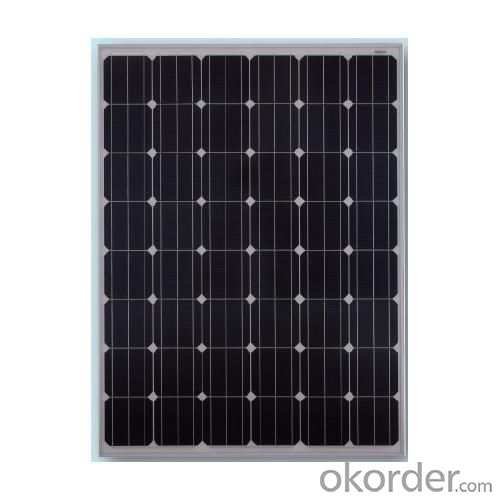

FAQ
1. Q: Do you have your own factory?
A: Yes, we have. Our factory located in Jiangyin city, jiangsu province.
2. Q: How can I visit your factory?
A: Before you take off from your country, please let us know. We will show you the way,or arrange time to pick you up if possible.
3. Q: Do you provide free sample?
A: Usually we do not offer free sample
4. Q: Could you print our company LOGO on the nameplate and package?
A: Yes, we can do that.
- Q:How do solar panels withstand harsh weather conditions?
- Solar panels are designed to withstand harsh weather conditions through their durable construction materials and protective features. The panels are made with tempered glass that can handle hail, heavy rain, and snow without getting damaged. The frames are typically made of strong aluminum or stainless steel to provide stability and resistance against strong winds. Additionally, advanced solar panels have built-in drainage systems to prevent water accumulation and snow shedding technology to remove snow buildup. These design elements enable solar panels to endure and continue generating electricity even under challenging weather conditions.
- Q:Can solar panels be used in areas with limited sunlight?
- Yes, solar panels can still be used in areas with limited sunlight. While solar panels are most efficient in areas with abundant sunlight, they can still generate electricity even in areas with limited sunlight. However, their output may be lower compared to areas with more sunlight. Additionally, advancements in solar technology, such as the use of more efficient panels and energy storage solutions, have made it more feasible to use solar panels in areas with limited sunlight.
- Q:Can solar panels be damaged by hail?
- Yes, solar panels can be damaged by hail. Hailstones can cause cracks or breaks in the glass surface of solar panels, potentially reducing their efficiency or causing them to stop working altogether. However, the extent of damage largely depends on the size and intensity of the hailstorm, as well as the quality and durability of the solar panels.
- Q:Do solar panels work with any type of heat or only sunlight? I have a bunch of little ideas floating around in my head and Id like to get them on paper but only if they really would work.Also does a concentrated amount of heat on one solar panel piece (quot;xor so) produce a higher or equal amount of electricity than a less concentration over a larger area?
- solar panel just suit the sunshine.because it has big light intensity . it can make solar panel produce electric charger.
- Q:Can solar panels be used in areas with high levels of wind-blown debris?
- Yes, solar panels can be used in areas with high levels of wind-blown debris. However, it is important to choose durable and robust solar panels designed to withstand such conditions. Regular cleaning and maintenance might be required to ensure optimal performance and longevity in these environments.
- Q:how long till a 50 watt solar panel pays itself off in buffalo, ny if its $500. i have national grid and heres the link to the rates. i am residential.
- I have a small system and do not make enough to sell back (no batteries) so it was less than 7 years BUT when you are talking about putting the initial in to a high yield div account and comparing it then I would say it took only 4 years to pay for because I was invested like many others with the capital it would have taken to get a large system and that investment LOST money while my solar pays for itself every year bit by bit. With systems now more efficient and rebates bigger and the investment alternatives not any better it is an easy choice.
- Q:How do solar panels affect the property's long-term financial viability?
- Solar panels can significantly enhance the long-term financial viability of a property. By generating clean and renewable energy, solar panels can help reduce electricity bills, providing substantial savings over the life of the system. Moreover, investing in solar panels can increase the property value, making it more attractive to potential buyers and potentially resulting in higher resale prices. Additionally, solar panels can provide a stable and predictable source of electricity, protecting the property from future energy price fluctuations.
- Q:I'm looking into buying solar panels, there are all kinds of ranges of energy output...but my question is, when ti says...say 50 watts of power...does that mean 50 watts a day, an hour, a minute, what?
- A 50-watt rating means the panel will produce 50 watts as long as the standard conditions are maintained. So if you had this bright sun and cool temperatures for 6 hours, the panel would deliver 50 x 6 = 900 watt hours, or a little shy of kilowatt-hour. Kilowatt-hours (kWh) is the reading on your electric bill. However, like most advertising, the 50-watt number is not realistic. They assume that the air surrounding the panel is very cold. 25 watts is a better number to use for this size of panel for engineering purposes.
- Q:How much electricity does a solar panel produce?
- The amount of electricity a solar panel produces depends on various factors such as its size, efficiency, location, and weather conditions. On average, a standard-sized solar panel can generate around 250 to 400 watts of electricity per hour under optimal conditions. However, this output can vary significantly throughout the day and across different seasons.
- Q:Ok so i can have a problem i have two 5 watt 2 volt solar panels a 2 volt battery and a 400 watt ac 2 volt dc inverter i believe im only getting 5 watts from from my solar panels thats the equivalent of one is there any way i could get full voltage from my solar panels without theoretically burning my wallet.. please help
- I think you need to take some basic courses on electricity. Usually, 8 volt solar panels are required to charge 2 volt batteries. The voltages of photovoltaic cells are set by the material they are made of, only current changes. If you hook up a 2 V solar panel to a 2 V battery, no current will flow, nothing would get charged. You would need some elaborate DC to DC voltage converters to charge a 2 V battery from 2 V solar panels. Solar panels can be connected in parallel or in series, as you've made the mistake of buying 2 V solar panel, you would have to wire them in series and have a charge controller that could limit the voltage of the charge. Did it ever occur to you that two 5 watt solar panels would not be able to provide the power needed by a 400 watt inverter? You're just running off your battery with your set up. Solar power is expensive power, you can not have solar without burning a hole in your wallet.
1. Manufacturer Overview |
|
|---|---|
| Location | |
| Year Established | |
| Annual Output Value | |
| Main Markets | |
| Company Certifications | |
2. Manufacturer Certificates |
|
|---|---|
| a) Certification Name | |
| Range | |
| Reference | |
| Validity Period | |
3. Manufacturer Capability |
|
|---|---|
| a)Trade Capacity | |
| Nearest Port | |
| Export Percentage | |
| No.of Employees in Trade Department | |
| Language Spoken: | |
| b)Factory Information | |
| Factory Size: | |
| No. of Production Lines | |
| Contract Manufacturing | |
| Product Price Range | |
Send your message to us
Solar Polycrystalline 156mm Series (40W-----50W)
- Loading Port:
- Shanghai
- Payment Terms:
- TT OR LC
- Min Order Qty:
- 1000 watt
- Supply Capability:
- 20000000 watt/month
OKorder Service Pledge
OKorder Financial Service
Similar products
New products
Hot products
Related keywords
